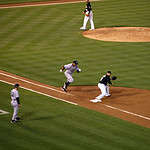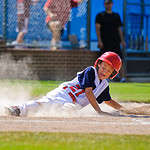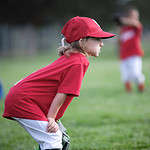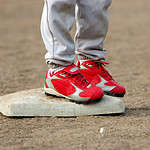A putout is a fundamental statistic in baseball that measures a defensive player’s role in recording an out. Putouts are credited to fielders who record the first out of an at-bat, or who make the final out of a play. Putouts are one of the most essential statistics in baseball, and they are used to evaluate the effectiveness of defensive players.
Putouts are a critical part of baseball because they measure the success of a team’s defense. The ability to make a putout is crucial for fielders, as it can help prevent runs from being scored. Putouts can be made in a variety of ways, including catching a fly ball, tagging a runner, or stepping on a base before a runner reaches it. Understanding how putouts work is essential for anyone who wants to understand the game of baseball.

What is a Putout in Baseball?
Definition
In baseball, a putout is a statistic credited to a fielder who records an out by catching a batted or thrown ball, tagging a baserunner, or forcing out a baserunner. A putout can be recorded by any fielder, but most commonly by the catcher, first baseman, or any outfielder.
A putout is also credited to a fielder who records the third out of an inning, regardless of how the out was made. This is known as an automatic putout and is recorded in the box score as “PO” or “AI”.
Examples
Here are some examples of how a putout can be recorded:
- A fielder catches a fly ball hit by the batter before it touches the ground or any other fielder. This is called a fly out and is credited as a putout to the fielder who caught the ball.
- A fielder tags a baserunner who is off the base and not touching it. This is called a tag out and is credited as a putout to the fielder who made the tag.
- A fielder forces out a baserunner by stepping on the base before the baserunner reaches it. This is called a force out and is credited as a putout to the fielder who touched the base.
MLB Putout Leaders
Some of the all-time MLB leaders in putouts include Jake Beckley, Cap Anson, Ed Konetchy, and Eddie Murray. These players were known for their fielding abilities and ability to record outs.
Putouts are an important defensive statistic in baseball, and evaluating a player’s ability to record putouts can be helpful in assessing their overall fielding and defensive skills. In addition to putouts, other defensive statistics include assists, fielding percentage, and double plays.
Overall, putouts are an essential part of the game of baseball, and recording them accurately can help teams and players evaluate their performance on the field.
Types of Putouts
Flyout
A flyout is a type of putout that occurs when a batter hits a ball into the air and a fielder catches it before it hits the ground. The fielder who catches the ball is credited with the putout. Flyouts are also known as popups or fly balls.
Groundout
A groundout is a type of putout that occurs when a batter hits a ball on the ground and a fielder picks it up and throws it to first base before the batter can reach the base. The fielder who makes the throw to first base is credited with the putout. Groundouts are also known as ground balls or grounders.
Strikeout
A strikeout is a type of putout that occurs when a batter swings and misses at three pitches or when a batter takes three pitches for strikes. The catcher catches the third strike, and the batter is out. The catcher is credited with the putout.
Force Out
A force out is a type of putout that occurs when a fielder touches a base before a runner who is forced to run to that base can reach it. The fielder who touches the base is credited with the putout. Force outs can occur at any base.
Tag Out
A tag out is a type of putout that occurs when a fielder tags a runner with the ball before the runner can reach a base. The fielder who makes the tag is credited with the putout. Tag outs can occur at any base.
Unassisted Putout
An unassisted putout is a type of putout that occurs when a fielder makes a putout without the help of a teammate. For example, a first baseman may catch a pop-up hit by a batter and step on first base before the batter can reach it. The first baseman is credited with the unassisted putout.
In summary, putouts are an important defensive statistic in baseball that measure the number of times a fielder records an out. The different types of putouts include flyouts, groundouts, strikeouts, force outs, tag outs, and unassisted putouts. These types of putouts can occur at any base and involve different fielding positions such as catcher, first base, shortstop, outfielder, and infielder.
Fielding Positions Involved in Putouts
In baseball, a putout is a defensive statistic that is credited to a fielder who records an out by catching a batted or thrown ball, tagging a baserunner, or forcing a baserunner out. Putouts are an important part of defensive statistics and are used to evaluate a team’s and player’s defensive performance.
There are several fielding positions involved in putouts, including the catcher, first baseman, second baseman, third baseman, shortstop, and outfielders. Each position has its own responsibilities and techniques for recording putouts.
Catcher
The catcher is responsible for catching pitches from the pitcher and recording any strikeouts. They also have the opportunity to record putouts by catching popups or flyouts behind the plate or by tagging out baserunners attempting to steal or advance. Catchers also have the ability to record unassisted putouts by catching dropped third strikes.
First Baseman
The first baseman is responsible for recording putouts by catching throws from other fielders attempting to force out baserunners at first base. They also have the opportunity to record putouts by catching popups or flyouts hit to the right side of the infield.
Second Baseman
The second baseman is responsible for recording putouts by catching throws from other fielders attempting to force out baserunners at second base. They also have the opportunity to record putouts by catching popups or flyouts hit to the right side of the infield.
Third Baseman
The third baseman is responsible for recording putouts by catching throws from other fielders attempting to force out baserunners at third base. They also have the opportunity to record putouts by catching popups or flyouts hit to the left side of the infield.
Shortstop
The shortstop is responsible for recording putouts by catching throws from other fielders attempting to force out baserunners at second base or third base. They also have the opportunity to record putouts by catching popups or flyouts hit to the left side of the infield.

Outfielders
Outfielders are responsible for recording putouts by catching flyballs hit to the outfield. They also have the opportunity to record putouts by catching popups or flyouts hit to the infield or by throwing out baserunners attempting to advance.
In conclusion, each fielding position has its own responsibilities and techniques for recording putouts in baseball. These putouts are an important part of defensive statistics and are used to evaluate a team’s and player’s defensive performance.
Commonly Confused Defensive Statistics
Assist
Assist is a defensive statistic that is awarded to a player who helps another player make an out. This can include throwing the ball to another player who then makes the out. An assist is not awarded if the player who receives the ball does not make an out. For example, if a player catches a fly ball and then throws the ball to the pitcher, who then drops the ball, no assist is awarded.
Putouts
A putout is a defensive statistic that is awarded to a player who is responsible for making an out. This can include catching a fly ball or tagging a runner. A putout is awarded only if the player who makes the out is the final out of the play. For example, if a player catches a fly ball for the second out of the inning, but the next batter hits a single, no putout is awarded.
Fielding Percentage
Fielding percentage is a defensive statistic that is calculated by dividing the number of putouts and assists by the total number of chances. A chance is any play in which a defensive player has the opportunity to make a play. Fielding percentage is often used to evaluate a player’s defensive ability, but it can be misleading. For example, a player who has a high fielding percentage but does not have good range may not be as effective as a player who has a lower fielding percentage but is able to make more difficult plays.
In conclusion, it is important to understand the differences between assist, putouts, and fielding percentage when evaluating a player’s defensive ability. While each statistic provides valuable information, they should be used in conjunction with other metrics to get a complete picture of a player’s performance.
- UCLA Softball: Let’s Go Bruins! - February 12, 2024
- Youth Softball Helmet Buying Guide: Keep ‘Em Safe - February 12, 2024
- Youth Softball Pants: Our Top Picks for Your Top Player - February 12, 2024








